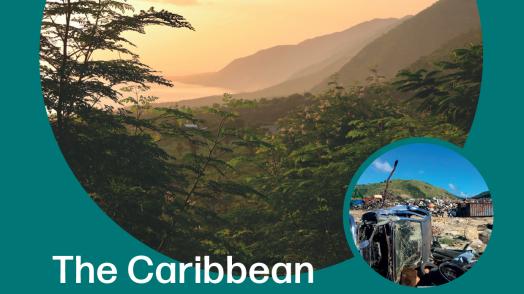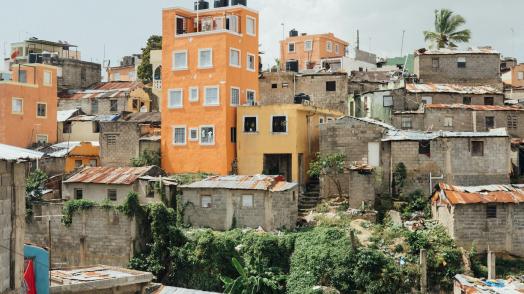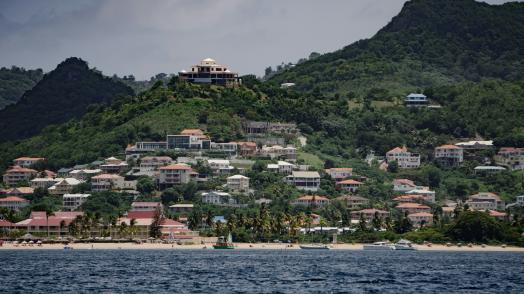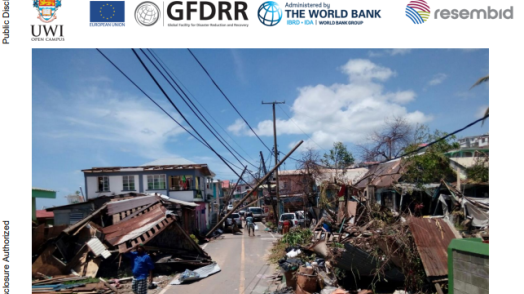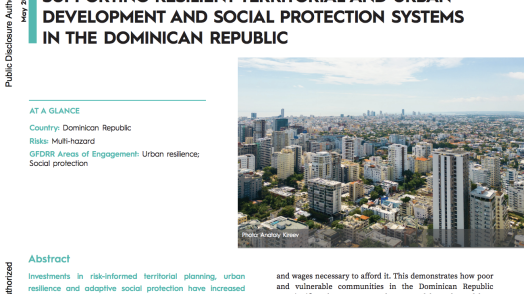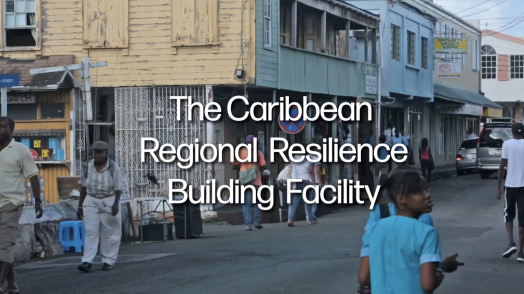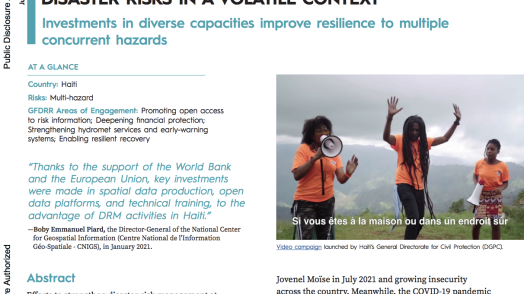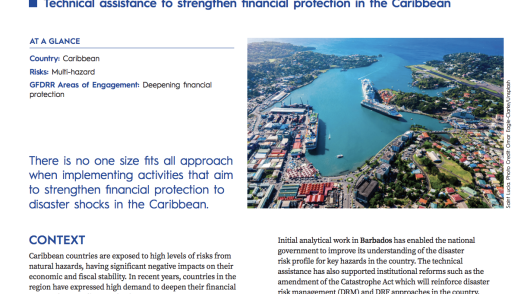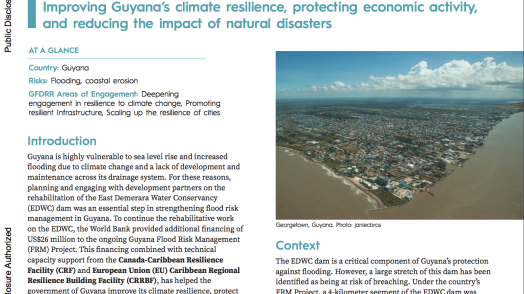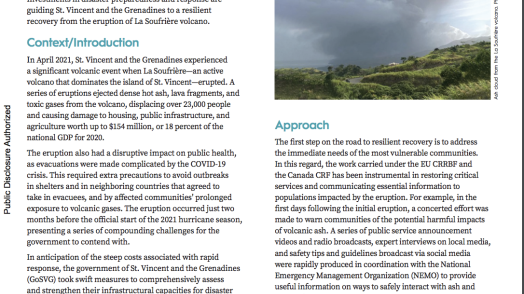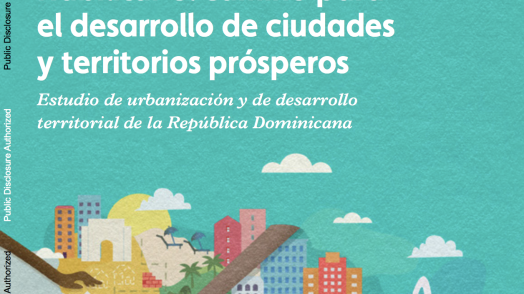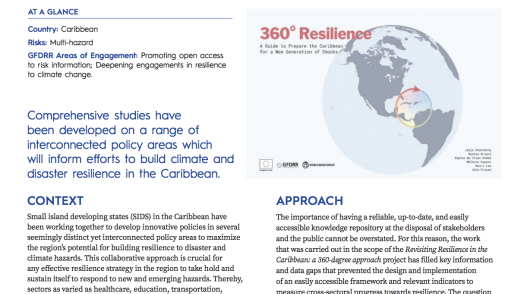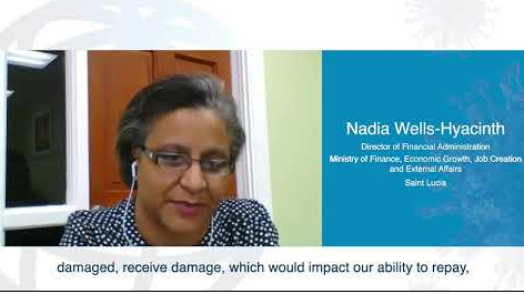The Caribbean region is exposed to a variety of natural hazards, including earthquakes, volcanoes, storms, extreme temperatures, droughts, floods and landslides, many of which are regularly aggravated by the recurrent El Niño / ENSO phenomenon. Increasing climate variability is likely to exacerbate many of these hazards.
Of every 10 natural events recorded in the Caribbean, seven arise because of storms and floods. The frequency of high-powered storms is such that for many small islands and low-lying coastal areas, this kind of events is considered as a “new normal”. The Category 5 hurricanes Irma and Maria which struck the region in September 2017 resulted in an estimated 100 deaths and severely damaged critical infrastructure, including housing, road networks, schools, hospitals, and water, electricity and phone utilities. Population growth and the ever-increasing concentration of infrastructure in urban or semi-urban areas have also been clear drivers of the growth in human and physical losses from adverse natural events.
Regional economies are extremely vulnerable to these disasters. Many Caribbean states have small and undiversified economic bases and high levels of indebtedness (an average of 79% of regional GDP) which limit their ability for critical investments in the aftermath of a disaster. As most Caribbean countries are categorized as middle-to-high income countries, they are largely ineligible for Official Development Assistance.
The devastating hurricanes which crippled the region in 2017 re-emphasized the need for enhanced regional cooperation for responding to these disasters. Caribbean nations are currently working on building economic resilience against extreme events, but this needs to be accomplished using a two-pronged approach: one that includes developing innovative risk insurance and debt reduction financial tools, while at the same time strengthening public infrastructure that can withstand and recover from disaster-induced shocks.
Learn more about the program
The Caribbean Regional Resilience Building Facility is a partnership between the European Union, GFDRR and the World Bank. The objective of the Facility is to enhance the long-term disaster resilience and adaptation capacity for the most vulnerable in the Caribbean region. This will be achieved through a comprehensive evidence-based effort, using various advisory and financial services and analytics available, to strengthen the capacity for disaster risk reduction and financial resilience at regional and national levels, as well as through co-financing of investments in resilience.
Activities of the Facility will cover the following beneficiary countries: Antigua and Barbuda, Bahamas, Barbados, Belize, Dominica, Dominican Republic, Grenada, Guyana, Haiti, Jamaica, St. Kitts and Nevis, Saint Lucia, St. Vincent and the Grenadines, Suriname and Trinidad and Tobago.
The program has three operational components:
- Regional Technical Assistance Facility to Mainstream Resilience. Activities within this component focus on providing institutional, policy, or regulatory advice to beneficiary countries on a demand-driven basis to strengthen the administrative and technical capacities for advancing recovery and resilience in key development sectors.
- Adaptation Facility for Leveraging Investments in Resilience in the Caribbean. Activities within this component focus on generating evidence-based information to support beneficiary countries as they make critical decisions on where to invest resources to become resilient and adapt to climate change. This technical advice, helps countries develop sector-specific probabilistic risk assessments to prioritize public investment plans in critical areas, which include: safe schools, shelters, public buildings, transport infrastructure, urban resilience, ecosystem-based adaptation, coastal zone management, flood mitigation measures, retrofitting of key infrastructure and integrated watershed management. Under this component, grants will be made available to either directly co-finance resilience investments or to finance ancillary technical assistance or financial services related to these investments.
- Expanding Financial Protection Against Disasters in the Caribbean Sovereign Countries. Activities within this component support beneficiary countries in expanding their coverage under the Caribbean Risk Insurance Facility – Segregated Portfolio Company (CCRIF-SPC) and related insurance and risk-reduction mechanisms. Specific activities build on CCRIF SPC’s current expansion plan, which includes increasing the portfolio size by improving the coverage limits of existing members, offering new products, and expanding membership. This component also aims to enhance countries’ understanding of financial protection products that target vulnerable populations and reduce the hazard risk to low-income housing.
The Caribbean Regional Resilience Building Facility is managed by the GFDRR secretariat, and activities are implemented by World Bank teams and beneficiary countries, in close coordination with EU Delegations to Caribbean countries and to regional and sub-regional organizations.
The Facility is funded by the European Union, and is being implemented in close collaboration with the EU Delegation to Barbados, the Eastern Caribbean States, the OECS and CARICOM/CARIFORUM.
The Facility is closely collaborating with stakeholders involved in Disaster Risk Reduction and Risk Financing in the Caribbean region, including the Caribbean Risk Insurance Facility – Segregated Portfolio Company (CCRIF-SPC).
Component 1 - Regional Technical Assistance Facility to Mainstream Resilience
- Caribbean Disaster Risk Financing Technical Assistance Program
- Disaster Resilience and Vulnerability Rapid-Response Household Phone-Survey
- Enhancing Resilient Territorial Development in the Dominican Republic
- Revisiting Resilience in the Caribbean: a 360 Degrees Approach
- Saint Vincent and the Grenadines - Preparing for Compounding Emergencies
- Strengthening Disaster and Climate Change Resilience in the Housing Sector in the Dominican Republic
- Strengthening Emergency Preparedness and Response Systems and the Climate and Disaster Resilience of Critical Infrastructure Services in Saint Vincent and the Grenadines
- Strengthening Preparedness, Response, and Resilient Recovery in Haiti
- Strengthening the Integration and Application of Resilient Technologies and Practices in Critical Work and Systems in Saint Lucia
Component 2 & 6 – Adaptation Facility for Leveraging Investments in Resilience in the Caribbean
- Building Physical, Fiscal, and Inclusive Resilience in Haiti
- Evaluating Flexible Approaches to Cash Transfers for Emergency Response in Haiti
- Improving Urban resilience of Coastal Cities in the Caribbean through Resilient Infrastructure and Urban Planning
- Informing the Shock-Responsive Targeting of Vulnerable Households in Haiti
- Mainstreaming Disaster Risk Management in Public Infrastructure Management in Haiti
- Resilient Housing and Affordability Assessments
- Resilient, Green, and Inclusive Flood Investment Baseline for the Georgetown Metropolitan Area
- Strengthening Financial Protection and Emergency Response in the Commonwealth of Dominica
- Strengthening Multi-Hazard, Emergency Preparedness and Response Systems in Saint Vincent and the Grenadines
- Technical Assistance to the Caribbean Regional Air Transport Resilience Project
Component 3 & 7– Expanding Financial Protection Against Disasters in the Caribbean Sovereign Countries
- Caribbean Physical and Financial Resilience Building Program
- Expanding Financial Protection Against Disasters in the Caribbean Member Governments Through the Caribbean Catastrophe Risk Insurance Facility – Segregated Portfolio Company (SPC)
- Support to the Caribbean Ocean and Aquaculture Sustainability Facility (COAST)
- November 2024: Video - The European Union, World Bank and GFDRR support to building resilience in the Caribbean
- April 2024: Feature story - Comprehensive Disaster Risk Financing for the Caribbean
- April 2024: Feature story - Building Resilience: Understanding and Managing Risk to the Housing Sector in the Caribbean
- January 2024: Results in Resilience story - Enabling Risk-Based Asset Management of Infrastructure in St. Lucia
- January 2024: Results in Resilience story - Strengthening Building Code Compliance and Enforcement in Dominica
- November 2022: Blog: SVG - The critical role of emergency operations centers in saving lives when disasters strike
- February 2023: Results in Resilience story - Enhancing Disaster Risk Financing in the Caribbean
- June 2022: Results in Resilience story - Supporting recovery and resilience in Saint Vincent and the Grenadines
- June 2022: Results in Resilience story - Strengthening Haiti’s resilience to multiple disaster risks in a volatile context
- May 2022: Urbanization and Territorial Development Review of the Dominican Republic (in Spanish)
- May 2022: Results in Resilience story - Supporting Recovery and Strengthening Flood Risk Management in Guyana
- March 2022: Discussion Paper: “Cash in the City: The Case of Port-au-Prince”
- February 2022: Video of initial results and achievements under the Caribbean Regional Resilience Building Facility
- February 2022: GFDRR Partnership Days - presentation of initial results and achievements of the Caribbean RRB Facility
- February 2022: Results in Resilience story - Enhancing Disaster Risk Financing in the Caribbean
- February 2022: Results in Resilience story - A "360 Degree" approach to Caribbean Resilience
- December 2021: Development of a virtual board game called Hurricane Hurry that confronts the audience with the individual and collective challenges of balancing investments in disaster risk management and financing. An introductory video about the game was also developed.
- November 2021: World Bank Flagship Report - 360 Degree Resilience: A Guide to Prepare the Caribbean for a New Generation of Shocks
- October 2021: Feature Story: Haiti’s Path to Building Financial Resilience Against Disasters
- June 2021: Feature story - In anticipation of the 2021 Atlantic Hurricane season, 19 Caribbean and 3 Central American governments renew their disaster risk insurance.
- April 2021: Following the eruption of the La Soufrière volcano in Saint Vincent and the Grenadines, three videos were produced to build awareness of the potential harmful impacts of volcanic ash and disseminated on Twitter: Breathing Ash ; Protect Home ; Local Calypsonian.
- April 2021: Feature story - European Union approves USD 150,000 to support St. Vincent and the Grenadines in volcano eruption response
- February 2021: Feature story - Haiti's path to building resilience to multiple disaster risks in a fragile context - the importance of partnerships
- November 2020: Videos - Haiti Hydrometeorological Unit inter-institutional workshop and open doors day
- October 2020: Feature story - Enhancing disaster preparedness in Haiti
- July 2020: Feature story - Facing drought, COVID-19 (Coronavirus), and hurricane season, Saint Lucia bolsters its disaster
- January 2020: Updated Program Brochure - The Caribbean Regional Resilience Building Facility
- June 2019: Feature story - Closing the financial protection gap – how Caribbean countries are coping
- June 2019: Video - Working together for a resilient Caribbean
- January 2019: Program Brochure - The Caribbean Regional Resilience Building Facility
- January 2019: Video - Voices of a Resilient Caribbean
Haiti
- Haiti - Flood Hazard Maps
- Hurricane Season, a project with the World Bank and Civil Protection in Haiti
- Video - Haiti Hydrometeorological Unit inter-institutional workshop
- Video - Haiti Hydrometeorological Unit open doors day
- Feature story - Haiti: applying innovative, affordable, and replicable solutions using drones and spatial data
- Cash in the City : The Case of Port-au-Prince
Dominican Republic
Saint Lucia
- Results Brief on phone surveys
- Potential of Lidar in St. Lucia
- NEMO Training in new disaster management digital platform
Saint Vincent and the Grenadines

